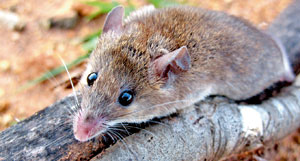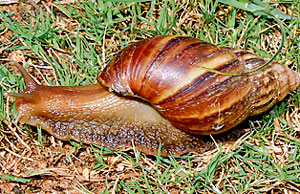The 2011 update of the Global Red List of Threatened Species that was released on June 16 highlights the prevailing crisis.
According to the latest report 707 species are already extinct, 64 extinct in the wild and 3,801 critically endangered on a global scale. The loss of biodiversity has become one of the world’s most pressing environment crises, with many species falling to critically low levels. Many species are becoming extinct unnoticed, and the number of species classified as Critically Endangered (those facing the most severe risk of becoming extinct) are increasing, the report states.
 |
Sri Lanka Spiny Mouse – a Critically Endangered small mammal.
Pic by Sampath Goonatilake |
The International Union for Conservation of Nature (IUCN )Red List of Threatened Species (or the IUCN Red List) is the world’s most comprehensive information source on the global conservation status of plant and animal species. It is based on a system that assesses the risk of extinction.
Species are assigned to one of eight categories of threat based on whether they meet the criteria linked to population trend, population size and structure and geographic range. Species listed as Critically Endangered, Endangered or Vulnerable are collectively described as ‘Threatened’. So according to the latest update, over 19,000 species are threatened out of 59,508 assessed species.
Estimates from the IUCN Red List indicate that extinctions take place at anytime from 100 to 1,000 times the ‘background’ or natural rate. The causes for extinction include habitat destruction, land conversion for agriculture and development, climate change, pollution, illegal wildlife trade, and the spread of invasive species.
The Global IUCN Red List also includes review of conservation status of many species that inhabit Sri Lanka. Globally assessed species occurring in Sri Lanka as per the latest update indicate 22 Extinct, 137 Critically Endangered and 164 Endangered. However, this global assessment took to account only 2065 species in Sri Lanka.
What was published this week was the Red List update on a Global Scale and every country processes its own assessment to evaluate the species vulnerabilities to extinction on a national level. In Sri Lanka, the Biodiversity Secretariat of the Ministry of Environment conducted this study with the assistance of key scientists.The head of this unit, Gamini Gamage said the current study covered more groups of animals and plants than the previous National Red Llist evaluation completed in 2007. He is positive that the latest update of the National Red List too can be released within this year, as most of the reviewing meetings were completed.
The findings of the previous National Red List assessment were also alarming for Sri Lankan fauna and flora. The national report published in 2007 highlighted 33% (223 species) of inland vertebrate fauna and 61% (675 species) of the evaluated flora were found to be nationally threatened. The threatened fauna and flora included many endemic species, which meant that if they became extinct, it would be a global loss. 21 species of endemic amphibians and 72 species of plants seem to have disappeared from the island (extinct) during the past century according to the report.
The data between the National and Global Red Lists can also differ considering their rigorous reviewing process that is time consuming. Because of this, threatened categories even of some of the endemic species could be different from the global assessment. For example, the Sri Lanka Spiny Mouse (Mus fernandoni) categorized in the National List as a Critically Endangered species is still under the category of Endangered in the Global Red List. However, the Red List is the best instrument available to assess the threatened species, point out experts.
However the future is not totally bleak. The 2011 Red List update promotes Arabian Oryx from the category of ‘Endangered’ to ‘Vulnerable’ . It is believed the last wild animal was shot in 1972 wiping them out from their natural range. This year, thanks to successful captive breeding and re-introduction efforts, the Oryx has finally qualified to move out of the endangered category to Vulnerable on the IUCN Red List—the first time that a species that was once Extinct in the wild has improved by three categories.
Once the scientists do their part, it is the task of the policy makers and implementors to take necessary conservation actions.
Biodiversity under attack by alien species
“The Alien Invasive Species is one of the biggest threats to the unique biodiversity of Sri Lanka. It is placed 3rd in the scale of threats, only behind Habitat loss and Habitat degradation,” revealed Dr. Devaka Weerakoon, a lead Consultant of the latest National Red List Assessment, addressing the monthly forum organized by the Wildlife and Nature Protection Society.
Invasive species are those that spread outside their natural past or present distribution range and threaten native species and habitats in those new areas. Invasive species has become a major threat worldwide and governments have to spend lots of money to control them. Citing the example of Coconut industry, Dr.Weerakoon pointed out that coconut has become the worst hit crop due to invasive species. Some time back coconut trees were attacked by the coconut beetle but the latest and more dangerous threat is an invasive Micro Plasma spreading in the south forcing authorities to cut down a large number of infected trees.
 |
| Invasive Giant African snail |
Dr. Weerakoon who was involved in compiling the previous Red Lists of Threatened Species of Sri Lanka, is currently leading a team under the Biodiversity Secretariat of Sri Lanka to evaluate the current threatened categories of Sri Lankan Fauna and Flora. He is also involved in an Invasive Species evaluation project conducted by the Biodiversity Secretariat.
Most of our National Parks too are being invaded by some kind of Invasive Plant. For example it is well known that in Udawalawa Park the invasive Lantana camara (gandapana) has become a major threat. Herbivores animals do not eat Lantana, so they spread fast also shrinking the feeding grounds of herbivorous animals such as elephants. Similarly, the Bundala National Park is invaded by Prosopis juliflora (kalapu andara), Opuntia stricta (cactus). The Hortan Plains faces a different threat from Ulex europeaus which is a thorny bush. Dr. Weerakoon pointed out that annually the government spends millions of rupees to remove these invasive plants. But the efforts have been unsuccessful as it has to be a continuous process where the removal has to be done in several cycles without allowing the plants to re-emerge.
He said though most of the protected areas in the Dry Zone are facing the threat of invasive species, the Wet Zone rainforests which are major habitats for Sri Lanka’s unique endemic biodiversity like Sinharaja and Peak Wilderness are relatively safer from worst forms Invasive plants. However Dr. Weerakoon stressed the need to keep an eye on these special biodiversity hotspots as once the invasive plants spread, it is hard to control it.
Sri Lanka’s freshwater aquatic systems too are invaded by many fish introduced on purpose or inadvertently. The Thilapia which was introduced to Sri Lankan waterways a few decades ago spread and ate other small native fish. The Rainbow Trout introduced in the Hill Country for fly-fishing, is believed to have killed off a native freshwater shrimp. The Knife Fish, Glass Cleaners are other species that have been released to the natural waterways in the course of aquatic trade.
Many Alien Invasive species also affect homegardens. The Giant African Snail, known as Kaluthara Snail which is common in our home gardens is such a species. They have fast spread across the country destroying many plants in home gardens.
Dr. Weerakoon also said that the problem of invasive species can be minimized by preventing the introduction of invasive species, eradicating a new invasion as soon as possible, containing a small or expanding invasion and if that fails managing the impacts and the presence of an established invasion. He also said awareness was the key to prevent new species being introduced and slowdown the spread. The Global Invasive Species Database has listed120 species as invasive to Sri Lanka. |



